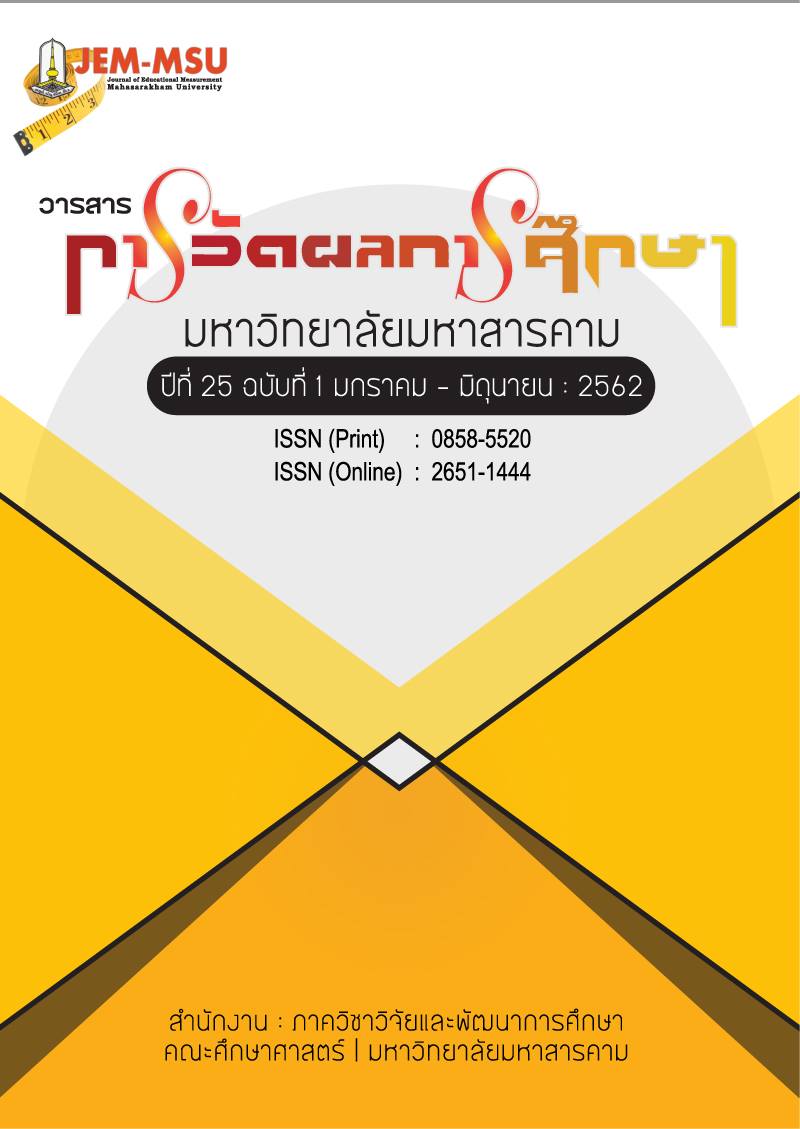Development of a Budget Allocation Model for Educational Institutions Under the Office of Vocational Education Commission
Main Article Content
Abstract
The purposes of the research were: 1. to study the structure of budget allocation of the educational institutions under the Office of Vocational Education Commission; 2. to study problems and obstacles of budget allocation of the educational institutions under the Office of Vocational Education Commission; and 3. to develop a budget allocation model of the educational institutions under the Office of Vocational Education Commission. The research methodology was of the Research and Development type. The research was composed of four steps. Step 1 dealt with a survey on the structure of budget allocation of the educational institutions under the Office of Vocational Education Commission by studying concepts, theories and research works related to the structure of budget allocation of the educational institutions under the Office of Vocational Education Commission. Then the data were treated with content analysis, and an analytic induction was made on the structure of budget allocation of the educational institutions under the Office of Vocational Education Commission. Step 2 dealt with the study of problems of budget allocation of the educational institutions under the Office of Vocational Education Commission. The research sample consisted of 29 college directors or persons in charge of the college budget. The data were collected through interviews. The tool used was a structured interview form. Then a content analysis was carried out and the conclusion on the problems of budget allocation of the educational institutions under the Office of Vocational Education Commission was made. Step 3 dealt with the construction of the budget allocation model which employed a focus group discussion of 10 experts and data were collected along the discussion. The research tool was a structured interview. Then a content analysis was carried out and the conclusion on the model of budget allocation of the educational institutions under the Office of Vocational Education Commission was made. Step 4 dealt with confirmation on the model of budget allocation of the educational institutions under the Office of Vocational Education Commission. The sample consisted of 301 college directors or persons in charge of the college budget, obtained through stratified random sampling. The research tool was a 5-point rating scale questionnaire containing 58 questions. The statistics employed in the analysis of data were descriptive statistics and the second order confirmatory factor analysis.
The results of the research are as follows:
1. The structure of the budget allocation of the educational institutions under the Office of Vocational Education Commission comprised: expenses which were composed of: 1) general administrative expenses and expenses on learning and teaching; 2) the national budget appropriated for the educational institution to be spent on personnel, operation, investment, subsidy and other expenses; 3) The off-budgetary fund which derived from incomes from outside sources. They were tuition fee, endowment, and from resource mobilization joined by parents, individuals, associations, government organizations and other agencies other than the Office of Vocational Education Commission.
2. Regarding problems and obstacles of budget allocation of the educational institutions under the Office of Vocational Education Commission, it was found that the national budget allocated to the educational institution was not adequate for providing education; the allocation was late and the disbursement was overdue; the budget was limited, the college had to use the money intended to support learning and teaching on hiring personnel; the personnel expenditure was high, particularly the cost of hiring special teachers; government officials and permanent government workers were inadequate, so a lot of money was spent on hiring temporary workers and special teachers; utility cost was high, according to the changing circumstance; and the national budget for learning and teaching was inadequate.
3. The result of the development of the budget allocation model of the educational institutions under the Office of Vocational Education Commission revealed that the budget allocation model of the educational institutions under the Office of Vocational Education Commission had 4 factors. They were: policy, mission, strategy, and asset and income. The results of the second order confirmatory factor analysis revealed that the model was consistent with the empirical data, with χ2 = 173.844, df = 98, p = 0.0210, GFI = 0.935. The adjusted goodness of fit index (AGFI) was .961. The loading of each factor ranged from .317 to .837 and every factor was statistically significant at the 0.05 level. This indicates that the structure of the measuring model of the budget allocation of the educational institutions under the Office of Vocational Education Commission was valid according to the theory.
Article Details
The content and information contained in the published article in the Journal of Educational Measurement Mahasarakham University represent the opinions and responsibilities of the authors directly. The editorial board of the journal is not necessarily in agreement with or responsible for any of the content.
The articles, data, content, images, etc. that have been published in the Journal of Educational Measurement Mahasarakham University are copyrighted by the journal. If any individual or organization wishes to reproduce or perform any actions involving the entirety or any part of the content, they must obtain written permission from the Journal of Educational Measurement Mahasarakham University.
References
ประเสริฐ ปิ่นปฐมรัฐ และคณะ. (2549). การพัฒนากระบวนการบริหารจัดการระบบงบประมาณ มหาวิทยาลัยเทคโนโลยีราชมงคลธัญบุรี โดยระบบงบประมาณแบบมุ่งเน้นผลงานตามยุทธศาสตร์ชาติ. ปทุมธานี:มหาวิทยาลัยเทคโนโลยีราชมงคลธัญบุรี.
รุ่ง แก้วแดง. (2546). โรงเรียนนิติบุคคล. กรุงเทพฯ: วัฒนาพานิช.
สกนธ์ ชุมทัพ. (2554). รายงานผลการศึกษาวิจัยการติดตามประเมินผลเพื่อตรวจสอบการยกระดับคุณภาพการศึกษาที่มีผลมาจากการเพิ่มงบประมาณเงินอุดหนุนค่าใช้จ่ายต่อหัวสำหรับการศึกษาขั้นพื้นฐาน. กรุงเทพฯ: สำนักงานปลัดกระทรวงศึกษาธิการ.
สำนักงบประมาณ. (2545). ระเบียบว่าด้วยการบริหารงบประมาณ พ.ศ. 2545. กรุงเทพฯ: สำนักงบประมาณ.
_____________. (2553). หลักการจำแนกประเภทรายจ่ายตามงบประมาณ (ฉบับปรับปรุง). กรุงเทพฯ : อัดสำเนา.
อมรวิชช์ นาครทรรพ และคณะ. (2547). การศึกษาสภาพปัญหาค่าใช้จ่ายของสถานศึกษาและผู้ปกครองภายหลังมีการจัดสรรเงินอุดหนุนรายหัวจากรัฐบาล. กรุงเทพฯ: กระทรวงศึกษาธิการ.
อาภรณ์ แก้วสลับศรี. (2552). ระบบงบประมาณ จากแบบแสดงรายการ สู่แบบมุ่งเน้นผลงาน. สงขลา: กองแผนงาน มหาวิทยาลัยทักษิณ.
อารีลักษณ์ พงษ์โสภา. (2545). กระบวนการงบประมาณที่มีความสัมพันธ์กับสัมฤทธิ์ผลของการบริหารงบประมาณ กรณีสำนักงานการศึกษาจังหวัดชัยภูมิ. วิทยานิพนธ์ศิลปศาสตรมหาบัณฑิต มหาวิทยาลัยขอนแก่น.
อุไร รับพร. (2552). สภาพปัญหาและแนวทางแก้ปัญหา การบริหารงบประมาณเงินอุดหนุน ปัจจัยพื้นฐานสำหรับนักเรียนยากจน ของสถานศึกษาขั้นพื้นฐาน สังกัดสำนักงานเขตพื้นที่การศึกษาปทุมธานี เขต 2. วิทยานิพนธ์มหาวิทยาลัยธุรกิจบัณฑิตย์.


